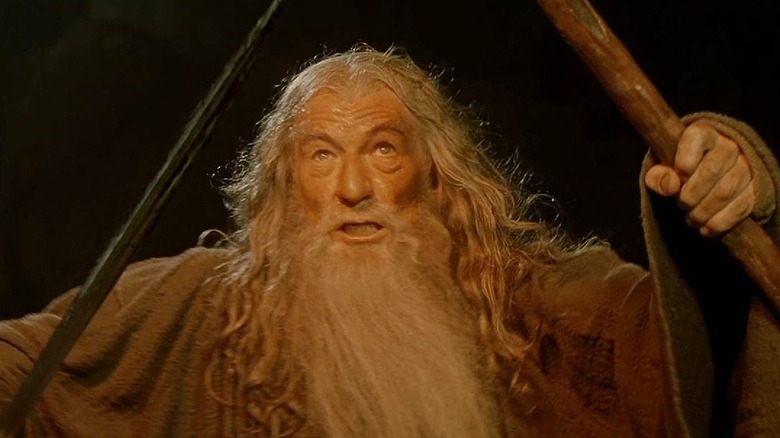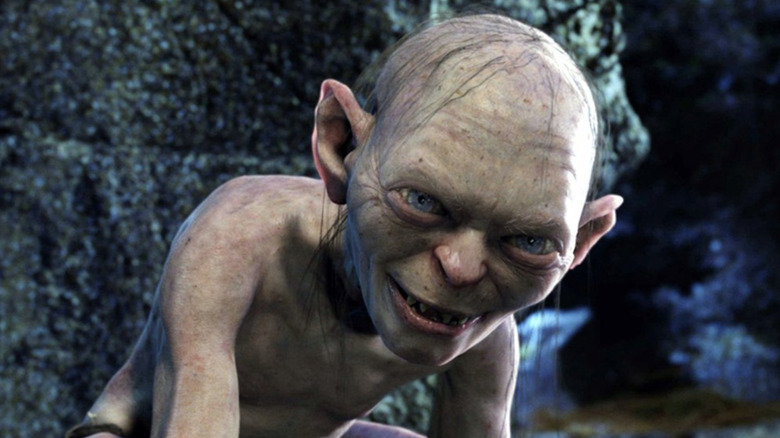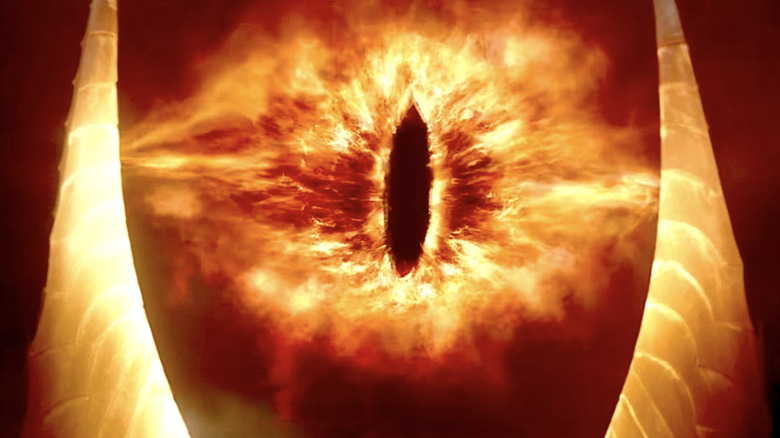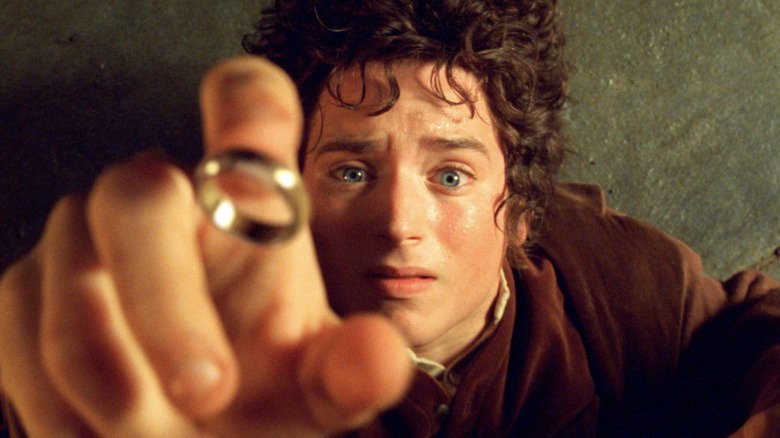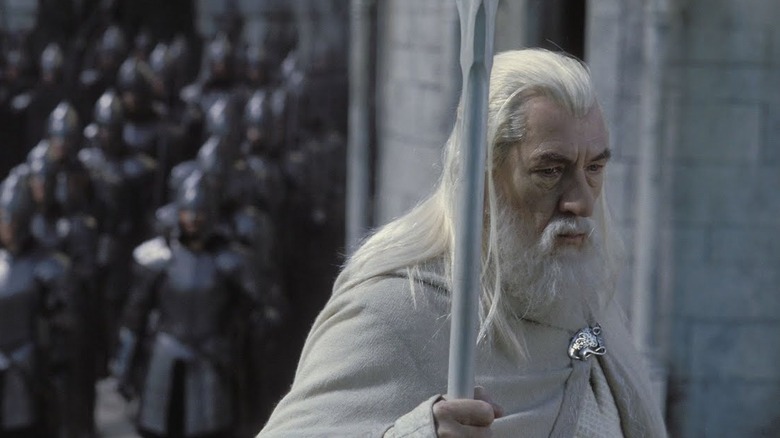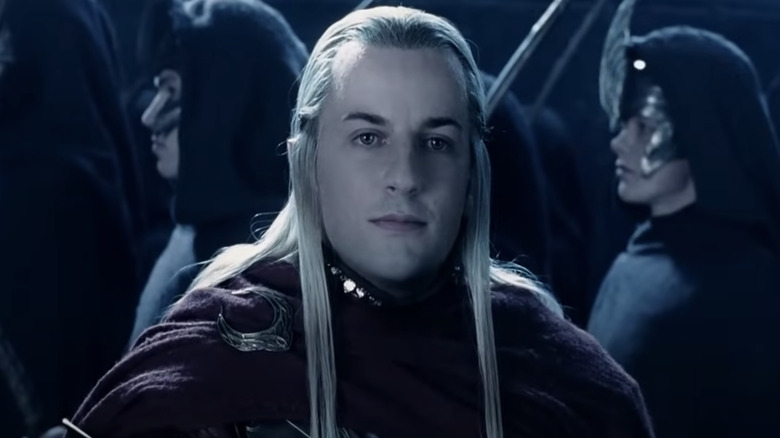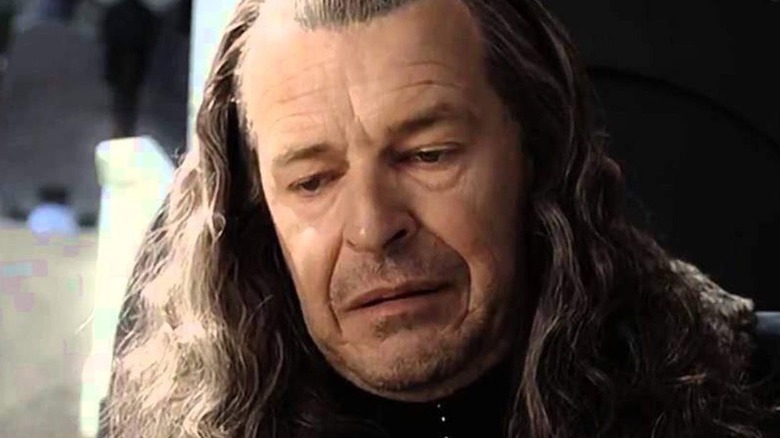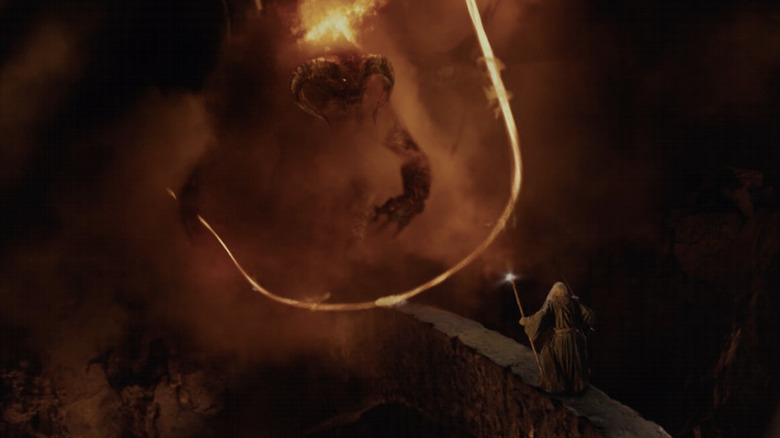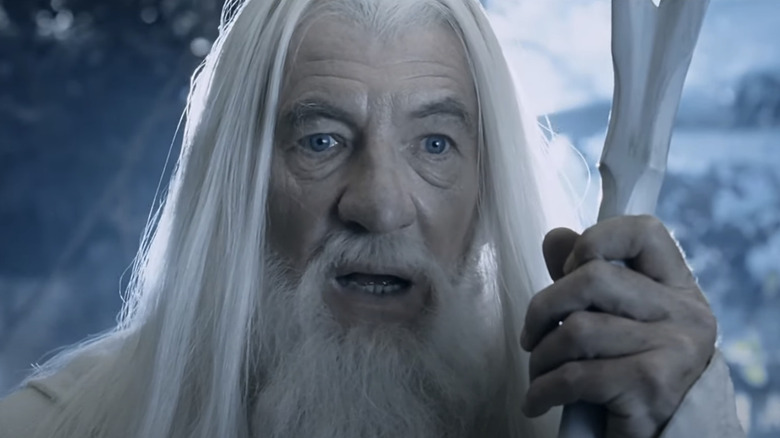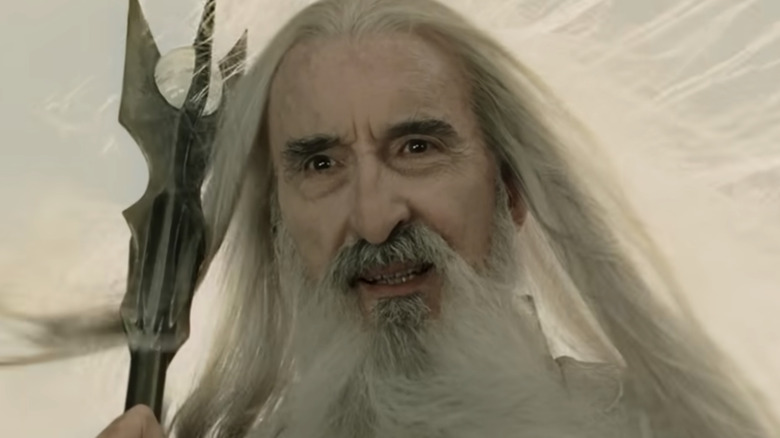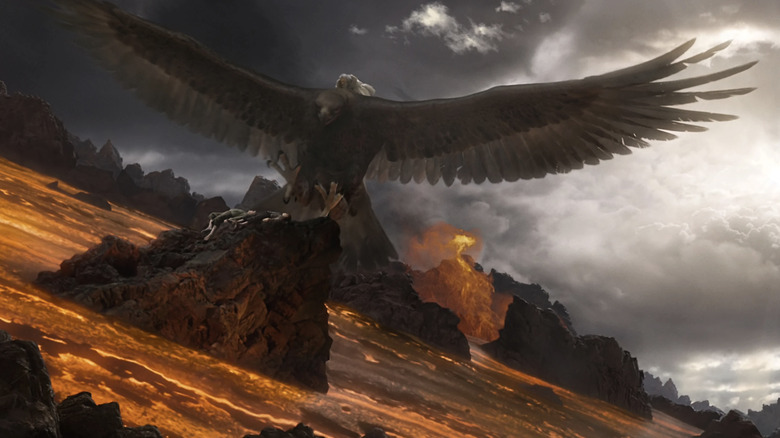Biggest Plot Holes In The Lord Of The Rings Movies
Every story has its plot holes, even some of the greatest ones. As it turns out, this literary truth even extends to Peter Jackson's cinematic adaptations of J.R.R. Tolkien's "The Lord of the Rings." The motion picture trilogy earned a total of 17 Academy Awards during its run (out of the total 30 it was nominated for), and has since been considered one of the greatest film trilogies of all time — and for good reason. As Jackson brought Tolkien's Middle-earth to life, audiences everywhere were captivated by this fantasy world we all wish we could be a part of.
Despite its success, not everyone was thrilled by Jackson's interpretation of Middle-earth. One such critic was none other than Tolkien's own son Christopher Tolkien, who maintained his father's estate for years. "The chasm between the beauty and seriousness of the work, and what it has become, has overwhelmed me," Tolkien said in a 2012 article (via World Crunch). "The commercialization has reduced the aesthetic and philosophical impact of the creation to nothing. There is only one solution for me: to turn my head away."
Nevertheless, fans have flocked to these films for decades now, and will likely continue to as time goes on. But even though this epic fantasy trilogy is so beloved, there are still some glaring plot holes worth addressing. After all, Jackson was not Tolkien, and he didn't have the luxury of expanding upon every detail along the way.
The Nazgul just give up on taking the Ring
One of the strangest moments in the Jackson trilogy occurs in Osgiliath at the tail end of "The Lord of the Rings: The Two Towers." As Sam (Sean Astin) notes, "By rights we shouldn't even be here," and he's correct. In the novels, Frodo (Elijah Wood) and Sam never venture through this part of Middle-earth, as Faramir (David Wenham) lets them go on their way to Mordor. The movies change that, and as a result, there's an interesting moment that occurs between Frodo and a Nazgûl.
While the city is under siege, Frodo, like a man possessed, wanders to a nearby structure where he encounters one of the Dark Riders on a fellbeast. The moment is intense, and as Frodo fingers the ring, he's only pulled away from being snatched up by the creature when Sam arrives at the last second. After getting shot with an arrow courtesy of Faramir, the Nazgûl and his winged companion depart, abandoning their pursuit of the One Ring. Though suspenseful, this moment doesn't make much sense when you think about it.
The Nazgûl were willing to fight Aragorn (Viggo Mortensen) in combat in pursuit of the Ring, so why give up now? Sure, Faramir's forces were down below, but these dark warriors of Sauron never showed fear like that before. It's a strange moment that doesn't quite add up and seems to negate what we know of the Nazgûl thus far.
Gollum's plan is a bit counter-intuitive
At the end of "The Two Towers," Gollum (Andy Serkis) decides to take Frodo and Sam on a detour through Mordor, one that will result in him handing the pair of hobbits over to "her." This "her" is in fact the giant spider demon Shelob, who appears in "The Lord of the Rings: The Return of the King." According to Gollum's plan, he'll deliver the hobbits to the spider, who will devour them, and then he'll claim the One Ring for himself off Frodo's corpse. But what the former hobbit fails to understand is that if Shelob eats Frodo, the Ring will likely go with him.
In Tolkien's world, it's revealed that Gollum once worked for Shelob as her servant, worshipping the creature and bringing her meals. This is meant to help explain how Gollum gets around in Shelob's lair in the book while Frodo and Sam are lost. It might also explain how Gollum could theoretically make a deal with the giant spider, claiming the Ring in exchange for presenting her with food and worship.
But the film doesn't touch on this and instead leaves us wondering how Gollum could possibly reclaim the Ring if Shelob is able to take Frodo for herself. Additionally, it's possible that Gollum hopes to get to Frodo while he's stuck in the creature's web, long before Shelob arrives to wrap him up, but the way the scene plays out dismisses the idea entirely.
How did Sauron become a giant flaming eye?
One of the biggest, and possibly most criticized, changes that Peter Jackson made to Tolkien's original material was turning Sauron into a giant flaming eye. No doubt, the visual is cool and adds a "Big Brother" component to the fallen spiritual being, but it's not terribly accurate. "He has only four [fingers] on the Black Hand," Gollum says in Tolkien's original work. "But they are enough." This implies that Sauron had a physical form at the time of "The Lord of the Rings," even if he didn't physically appear in the story.
But Jackson took a different approach. Taking Tolkien's imagery of Sauron's ever-present eye literally, he reimagines the villain as a massive fiery orb, searching aimlessly for his precious. Unfortunately, he never really explains how this happens. "He cannot yet take physical form," Saruman (Christopher Lee) tells Gandalf (Ian McKellen) in "The Lord of the Rings: The Fellowship of the Ring." "But his spirit has lost none of its potency." But how has he failed to get back most of his strength after all this time? The movie never says.
By "The Return of the King," Aragorn baits the Dark Lord to come out and fight him personally, seemingly forgetting that Sauron is only a spirit. Interestingly, Jackson did film an actual battle between Aragorn and Sauron that might have resolved this (with the Dark Lord having regained most of his power), though it was left out of the finished film.
Conflicting information on which hobbit has the Ring
We mentioned the moment between Frodo and the Nazgûl in Osgiliath, but at the beginning of the next film, "The Return of the King," Sauron learns of another hobbit in Middle-earth who may pose a threat. Upon looking into the palantír, Pippin (Billy Boyd) reveals himself to Sauron, a bit of information further confirmed when Aragorn grabs the crystal ball himself. Because of this, Gandalf and company assume that Sauron thinks Pippin has the Ring, which is part of why they split up, sending the wizard and the hobbit to Minas Tirith.
While Gandalf's decision to take Pippin to Gondor makes sense (thus throwing any suspicion off Frodo), wouldn't the Nazgûl already know which hobbit has the Ring? This would especially be true after encountering Frodo with it twice now. You'd think they would have reported that information to their Dark Lord, including a vivid description. Sure, it's made obvious that the Nazgûl don't have the best eyesight (oddly enough for a band of raiders who work for a giant eye), but encountering the ring-bearer in Osgiliath seems like pretty big news worth reporting.
Of course, Sauron likely thinks that Aragorn now possesses the Ring, giving into the temptation just like his ancestor back in the day. As such, the Dark Lord sets his sights on Gondor, and on the new king who is about to reclaim the throne.
The destruction of Gandalf's staff
Sometime after his arrival in Minas Tirith, Gandalf duels it out with the Witch-King, the vengeful leader of the Nazgûl. In this battle, Gandalf's new white staff is blown apart by the Witch-King, who then flies off (without nabbing Pippin for some reason). But something doesn't add up. Not only is Gandalf the White increasingly more powerful than Gandalf the Grey, but he should still theoretically be much stronger than a Nazgûl. Remember, this comes well after Gandalf fights a Balrog from "the lowest dungeon to the highest peak," so what gives?
As a white wizard, Gandalf is able to use a larger sum of his power on Middle-earth than he was permitted as Gandalf the Grey (hence his new title), and should easily be the most formidable foe to an undead creature like the Witch-King. One could argue that the destruction of his staff, as seen in the film's extended cut, doesn't make any real sense when you compare their respective power levels. Not to mention, "The Return of the King" ends with Gandalf once again holding his staff before venturing to the Gray Havens (it could be a new model, however).
Considering the ending, and how unnecessary breaking Gandalf's staff was in the first place, it's understandable why the scene — which isn't in the book — was cut from the theatrical edition.
How do zero Elves survive the Battle of Helm's Deep?
Another addition that Peter Jackson made to "The Lord of the Rings" was the inclusion of Elven warriors from Lothlórien in the infamous Battle of Helm's Deep (generally called the Battle of the Hornburg). Considering that the Elves' whole story is that they're leaving Middle-earth, it was an odd choice but works well enough within the context of "The Two Towers." What doesn't make a load of sense, especially since Legolas (Orlando Bloom) is shown to be a masterfully skilled fighter, is how just about all of them — most notably Haldir (Craig Parker) — die in the battle.
This is especially strange when you consider that so many of the men and boys of Rohan who fight and somehow survive aren't trained half as well as the Elves, who have had entire lifetimes to perfect their craft. This is likely part of the reason why Tolkien failed to include them in the battle in his novel (though Legolas wishes they were there). Jackson makes a big deal of their arrival here, and they do slow Saruman's forces down before they finally enter the Deep.
"All the Elves up there are cut off and killed" was a direction spoken on the set of "The Two Towers," effectively sealing their fate for those who may think there were survivors. Their heroism truly knew no bounds, even if it didn't fully make sense.
How did Denethor not die sooner?
One of the most horrific scenes in "The Lord of the Rings" is the moment in "The Return of the King" where Denethor (John Noble), erroneously thinking that Faramir has died, decides to burn himself alive — along with his son — as Minas Tirith is under siege. This casual defeat reveals a lot about the Steward of Gondor, and his retreat to death in the face of danger proves him a coward. It's no surprise that Pippin and Gandalf arrive to rescue the unconscious Faramir, but what does come as a shock is how quickly Denethor goes up in flames.
As the steward burns, we're left to wonder how long a person can survive something so ghastly, but more than that, how long they can still properly function as a result. Covered in oil, Denethor's flesh burns rapidly as he runs out of the crypts, through the courtyard, past the White Tree, and then off the ledge of the palace, plummeting to his doom. That's a long time for even a great man of Gondor to run while ablaze, even when compared to someone like Boromir (Sean Bean), who didn't venture very far with four arrows in him.
This is admittedly more of a nitpick than a plot hole, but it raises some serious questions that deserve to be answered. After all, he runs at least half a mile before falling to his death, and even then he's seemingly still breathing.
No discussion about the potential Balrog in Moria
In J.R.R. Tolkien's "The Fellowship of the Ring," the decision by Frodo to enter Moria only occurs after much debate about whether the journey is worth it. Ultimately, his decision is the same as in the film, but Tolkien presents it as a heated discussion (led by Gandalf, who brings the Dwarfish kingdom up initially) rather than a no-win scenario. To make matters worse, whereas Gandalf in the books doesn't necessarily know there's a Balrog lurking deep within the mines, the Gandalf seen in the Peter Jackson films seems to — and he doesn't say a word.
Instead, the blame is placed on Frodo for their venture into Khazad-dûm, which ultimately results in Gandalf's untimely death. "Needless were none of the deeds of Gandalf in life," Galadriel (Cate Blanchett) says after learning about Gandalf's death, a line from the book that doesn't quite make sense in the movie. In the book, Gandalf insists on their journey through Moria, but in the movie, it is against his better judgment.
Therefore, since it isn't Gandalf's decision (or even his desire), Galadriel's implication that the wizard knew what he was doing the whole time is, well, off. Of course, Gandalf does return as Gandalf the White and ends up aiding the Fellowship in a more meaningful way, but the way Peter Jackson unfolds it, it isn't exactly intentional.
Gandalf the White is never explained
Speaking of Gandalf the White, the wizard is transformed upon his rebirth from his former grey-clad appearance into what Saruman the White should have been all along. Some, such as "A Song of Ice and Fire" scribe George R.R. Martin, have criticized this choice, considering Gandalf the White as a "deus ex machina." But beyond the fact that Gandalf returns with even more power than before, many have pointed out that exactly how this happens is never really explained, and because "The Lord of the Rings" is a fantasy epic — and he's a wizard — we're meant to just go with it.
Now, before fans of the movies jump down our throats, it's true that Gandalf claims to be sent back, but by whom? In Tolkien's mythology, the creator God of Middle-earth, named Eru Ilúvatar, is above all other beings. Though he doesn't always directly intervene, he makes it a point to bring Gandalf back to see Sauron defeated, Aragorn crowned king, and Middle-earth saved. Just as Tolkien himself was a devout Catholic, so too does Gandalf represent a sort of Christ figure, with his death and resurrection ushering in a new age of Middle-earth.
Though the films don't touch much on Eru Ilúvatar, making the story behind Gandalf's resurrection something of a mystery to casual viewers, Tolkien's greater works do. Maybe this "plot hole" has been filled after all.
Saruman never tells Sauron about Frodo's quest
One big issue many fans have with "The Lord of the Rings" is that Sauron doesn't fortify Mount Doom to keep Frodo and Sam from entering it. While it might seem like a good criticism on the surface, it falls apart when you consider the even bigger plot hole glaring back at you. Why doesn't Sarumon tell Sauron about the Fellowship's plan? In the extended cut of "The Return of the King," a defeated Saruman taunts Gandalf before plummeting to his demise.
"Tell me, what words of comfort did you give the Halfling before you sent him to his doom?" Saruman says to Gandalf and his friends. "The path that you have set him on can only lead to death." Somehow, the former White Wizard has learned something about Frodo's mission, and knowing that both Pippin and Merry (Dominic Monaghan) are standing below him (combined with Sauron's knowledge of a "Baggins" who has the One Ring), it seems like information he should have shared with his Dark Lord. But he never does.
This isn't even an issue in Tolkien's novels, as Saruman never has this interaction with Gandalf in the first place, nor does he know anything about Frodo's quest. There, the evil wizard runs off, takes over the Shire, and attempts to rebuild his empire before Wormtongue (played by Brad Dourif in the movies) betrays and kills him, not unlike how he's killed in the movies. Well, minus the falling part.
Why didn't the Eagles fly them to Mordor?
The age-old problem that most folks have with "The Lord of the Rings" is by far the most obvious: why don't the Eagles just fly Frodo to Mordor, drop the Ring into Mount Doom from the air, and fly back off to the Shire? At the end of "The Return of the King," Gandalf sends the Eagles into the Dark Lord's domain to rescue the ring-bearer, an event that occurs in both the movies as well as the books. So if they could fly in then, why not sooner? Where were these majestic birds when the Fellowship first set off? It might have saved everyone a lot of trouble, not to mention heartbreak.
Well, believe it or not, this "plot hole" isn't as big a plot hole as one might think. For starters, the Nazgûl are seen on flying fellbeasts throughout the second and third films, which implies that there may be many more of these creatures defending Mordor. Secondly, Sauron watches over Mordor like a hawk. Frodo and Sam sneaking in is understandable because rocks and buildings provide plenty of cover, but if they fly in, they would surely be shot out of the sky. Lastly, the Dark Lord's army is still a viable threat within Mordor's walls.
Of course, beyond that, the giant Eagles of Middle-earth are sentient creatures with their own motives, and they're certainly not at everyone's beck and call.
